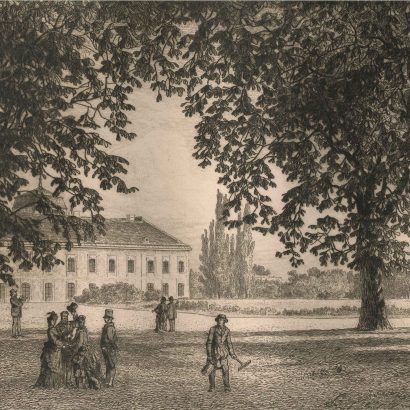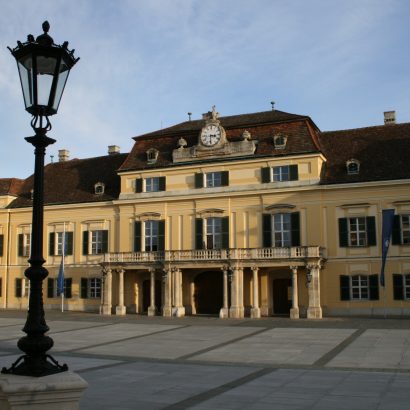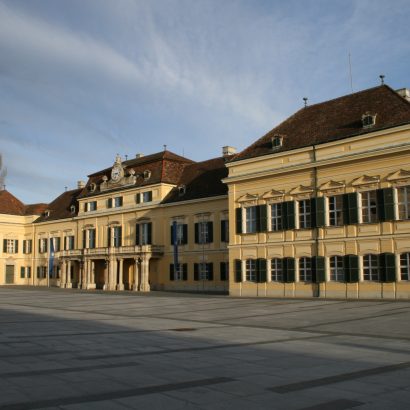The two castles
The Laxenburg palace complex has many features that are interesting from a cultural and historical point of view. One of these significant features is the existence of two castles: the Old Castle, Laxenburg's oldest building from the 12th century, and the New Castle, the Blauer Hof.
Altes Schloss
The Altes Schloss or old castle, originally – since the 13th century – the heart of an extended hunting ground, surrounded by moats and equipped with numerous ancillary buildings, today forms an important visual motif in the gardens.
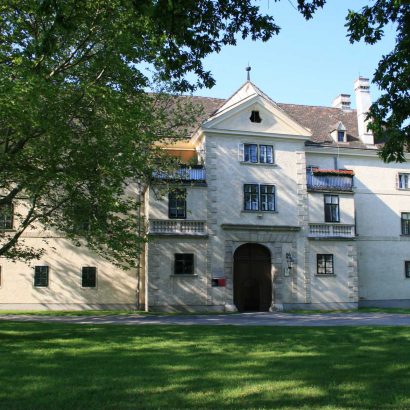
After the lords of “Lachsenburg” had died out, the Habsburgs acquired the entire grounds in the 14th century. Under Albrecht III, this hunting castle was expanded and developed. In the second half of the 17th century, after a period of decay, Lodovico Burnacini (the famous theatre architect of Emperor Leopold I.) renovated the park in the baroque style.
After an attack by the Turks in 1683, this building was reconstructed in 1693 and another floor was added. Until World War I, together with the Neues Schloss (the new castle), built in the 18th century, the Altes Schloss served as a spring residence for the Habsburgs. Between the WWI and WWII, it was home to the “Hellerau-Laxenburg” school for rhythm, music and physical education.
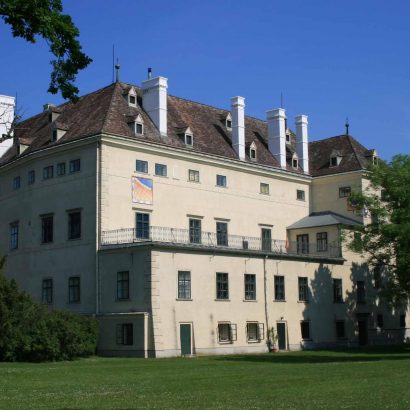
The sloping nature of the grounds had always made it difficult to lend them a regular design. The Renaissance garden constructed “in the Dutch manner” was, in the 16th century, somewhat remote, being located roughly in the area of todays theatre, and had no axial relationship to the Altes Schloss, which would then, in the baroque period, be integrated into the system of coordinates of avenues and lanes of an enlarged south-facing park. Located between this and the Uhlefeldhaus (originally to the south of the theatre, today no longer there) was a semi-circular large square with avenues of trees running through it, which was first included in the landscape design of the park during the first third of the 19th century.
Between the 1750s and 1770s, it was also considered whether this space should be made more attractive as a “park entrée” and even be flanked with buildings. The water basin with fountain dates from this period. The moats of the Altes Schloss were filled with earth in the second half of the 18th century and designed to as sections of lawn.
Blauer Hof
It was first referred to as a Freihof or free court under Melchior Arguello (Melchor de Argüello) in 1544. Later owners were the Bloe brothers (Bloenstain/Blauensteiner), Rätsch, Eibiswald and others. From 1705 Imperial Vice-Chancellor Friedrich Karl Schönborn was the owner, who had the existing structure generously expanded by his favourite architect, Lukas von Hildebrandt, between 1710 and 1720.
In around 1729, it was sold to his successor in the office of Vice-Chancellor, Duke Adolf Metsch, and on his death inherited by his son-in-law Khevenhüller-Metsch. The building was then owned by the Dukes Daun, who exchanged it for Dietrichstein Palace (= Grünne-Haus) in 1762.
Next Maria Theresia acquired the Blauensteiner-Hof and the adjacent Prucknerische Haus. As of 1756, a large extension was built by the court architect Nicoló Pacassi. Circa 1770 the Belvedere (paintings by Joseph Pichler?) was added. Pacassi modified the building, moving the entrance from the eastern to the northern side (i.e. the Schlossplatz or castle square).
The front of the entrance at the Schlossplatz is dominated by greatly brought forward corner projections, which follow the curved course of the border of the old village, which was built around a square. The central projection is emphasised by a portico, balcony and attic with a clock. In the Blauer Hof, the different forms of the pediments are notable as a reference to the main and additional wings. The interior decoration, insofar as it has been preserved, mainly dates from 1853/54.
The dining room wing
The dining room wing, probably built by Nicoló Pacassi, is located on the site of the former Sinzendorfischer Haus and came into imperial ownership in 1756. The entrance front is dominated by a portico with sculptures of heron hawking. Inside there is a large oval dining room, whose walls are lent form by architectural painting (unfortunately only parts of this have been preserved). The ceiling fresco by Vinzenz Fischer shows putti hunting with falcons.
The castle theatre
The castle theatre was built following designs by Nicoló Pacassi in 1753. On the park entrance side there is a high portico with a curved gable. The wall surfaces are structured by sunken fields and superimposed panels. As regards the interior decoration, only the late baroque painting in the illusionist architecture still remains. The upper zone with volutes, floral garlands and putti was added in the 19th century.
